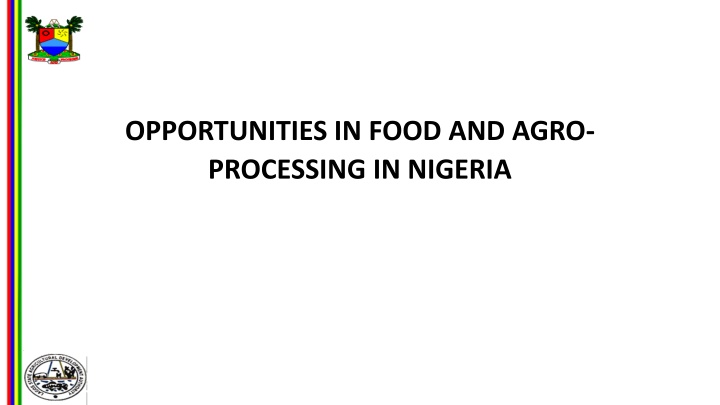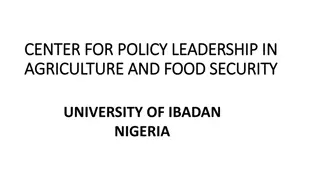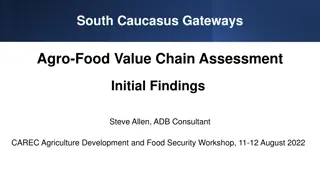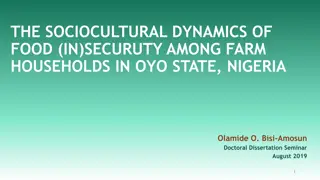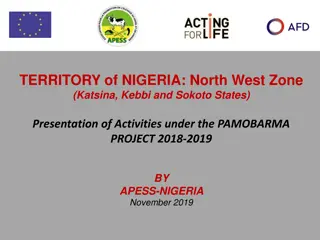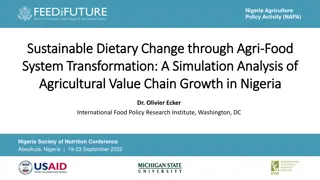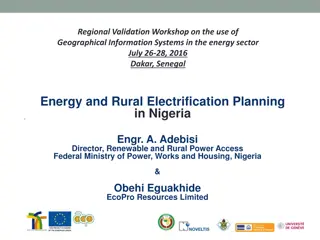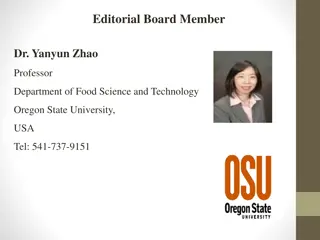Unlocking Opportunities in Food and Agro-Processing in Nigeria
Explore the potential for food and agro-processing in Nigeria to generate income, enhance food security, and boost the economy. Learn about the objectives, strategies, and reasons behind agro-processing activities, as well as the growing demand for convenience and processed foods in the country. Discover how value addition through processing can lead to job creation, reduced food losses, and improved nutrition for farmers.
Download Presentation

Please find below an Image/Link to download the presentation.
The content on the website is provided AS IS for your information and personal use only. It may not be sold, licensed, or shared on other websites without obtaining consent from the author.If you encounter any issues during the download, it is possible that the publisher has removed the file from their server.
You are allowed to download the files provided on this website for personal or commercial use, subject to the condition that they are used lawfully. All files are the property of their respective owners.
The content on the website is provided AS IS for your information and personal use only. It may not be sold, licensed, or shared on other websites without obtaining consent from the author.
E N D
Presentation Transcript
OPPORTUNITIES IN FOOD AND AGRO- PROCESSING IN NIGERIA
OPPORTUNITIES IN FOOD AND AGRO- PROCESSING IN NIGERIA
PRESENTED BY HEAD WOMEN IN AGRICULTURE AND NUTRITION LAGOS STATE AGRICULTURAL DEVELOPMENT AUTHORITY. TEL: 07038590492, 08073718271 EMAIL: jusbalog144@gmail.com
OBJECTIVES One of the major objectives of food and Agro processing is to generate passive income at the lowest possible risk and cost. Develop new value-added products. GOAL This webinar will provide significant private sector investment and government collaboration and support.
INTRODUCTION Adequate food intake and healthy nutritional status are the foundation block of a healthy, active and productive nation. Agricultural produce are highly perishable in nature. Value addition through processing is the way out. Agro-processing has the advantages of stimulating demand for farm produce and products and give consumers additional choice. Opportunities in food processing. Strategies for food and dietary diversification.
FOOD AND AGRO PROCESSING Food processing is any intentional change in food occurring before consumption. Changing consumer demographics related to lifestyle changes, urbanization, and tourism. Is a resulting in an increased demand for convenience and processed foods. Nigerian s agriculture and agribusiness industry is underperforming, And thus providing opportunities for investors to benefit from this huge market
The demand for convenience and processed food is growing in Nigeria This demand is led by Nigeria s expanding middle class, with consumer changes in tastes, patterns and style. Consumers are also becoming more health conscious, adding to the need for nutritious pre-packaged food. The food processing and packaging market report notes that Nigeria s packaging and food processing market is one of the largest in Africa, And estimated at about $545m. Between 2010 and 2012, imports of food
REASONS FOR AGRO- PROCESSING ACTIVITIES Diversification of the economy, in order to reduce present dependence on one export commodity Reduction of imports and meeting export demands; Stimulate agricultural production by obtaining marketable products; Generate both rural and urban employment; Reduce fresh produce losses; Improve farmers' nutrition by allowing them to consume their own processed fruit and vegetables during the off-season; Generate new sources of income for farmers/artisans; Develop new value-added products.
OPPORTUNITIES Despite the challenges. There is tremendous untapped potential in Nigeria s agriculture and agribusiness sector. In the third quarter of 2016, the sector grew 4.88% and has grown by as much as 13% in previous years. The Nigerian government is prioritising agriculture with growth plans of 6.9% from 2017-2020. Rice, cashew nuts, groundnuts, cassava and vegetable oil are products the country hopes to export by 2022. There are plans to make Nigeria self-sufficient in tomato, rice and wheat by 2019, 2020 and 2021/2022 respectively.
A broad range of food production and processing opportunities can be gleaned from The Green Alternative, Nigeria s agriculture promotion policy document. It is expected to unlock the sectors potentials, reduce dependence on crude oil export and ignite the growth of the Nigerian economy.
INVESTMENT OPPORTUNITY Investment opportunities in the agricultural value chain in the country are huge. The food distribution in Nigeria remains largely inefficient due to the factors such as crop seasonality, sub optimal storage technology and facilities, an inadequate transport and distribution system, Imperfect market information and behavior.
The poor storage facilities at household level alone results in significant post-harvest losses(cereals 25-30%; root crop 50-70%; fruits and vegetables 70%). This nexus results in considerable spatial and seasonal variation in food production and availability, and is responsible for he considerable range in food prices across the country. Thus one can invest in the following: Fresh fruits processing, foodstuff retailing or grocery service,
fish farming, herbs, flowers framing and gardening, livestock feed production, poultry farm, mushroom farming, frozen chicken production, and glasscutter farming
Potential agro entrepreneurs could also make useful investments in other areas, including: fish production, snail farming, coconut juice production, beekeeping and honey production, plantain chips production, custard manufacturing, fruit juice or jam production, groundnut processing, cashew nut processing, soya beans processing, spices production, dairy products, vegetable farming e.t.c
VALUE ADDITION Value Addition, is a Veritable Future for Agro Processing in Nigeria What is Value Added? Value added means adding value to a raw product by taking it to at least the next stage of production. adding value may be as elaborate as going all the way to the consumer with a case-ready food product. If you are considering a value-added enterprise, there are two key questions to answer:
WHAT IS CUSTOMER VALUE? Customer value reflects the relationship between the benefits customers receive from and the price they pay for a product. The more benefits relative to the price, the higher the customer value. This does not necessarily mean that greater value results from a low price. The price of a particular product may be high, but if the associated benefits are high as well, the customers perceive the product as valuable. This interaction creates customer value and, thus, the opportunity to add value to your product.
Creating customer value is critical in building a profitable and substantial business. However, one must bear in mind that it is the customers perception of value, not the producers , that is critical. It is also important to recognize that different customers have different perceptions of added value. These perceptions correspond to their expectations of quality, service, convenience and selection.
WHAT CREATES A VALUE-ADDED PRODUCT? QUALITY EASE OF POSSESSIONN FUNCTIONALITY VALUE FORM TIME PLACE
WHAT CREATES A VALUE-ADDED PRODUCT? Value is usually created by focusing on the benefits associated with the agribusiness product or service that arise from: Quality Does the product or service meet or exceed customer expectations? Functionality Does the product or service provide the function needed of it?
WHAT CREATES A VALUE-ADDED PRODUCT? Form Is the product in a useful form? Place Is the product in the right place? Time Is the product in the right place at the right time? Ease of possession Is the product easy for the customer to obtain?
A product must have one or more of these qualities to generate additional value. Remember that a product is simply. A bundle of benefits, And that the more benefits there are the more customers will perceive the product as having value.
DRIVE OF VALUE ADDITION Agro processing in Nigeria, particularly the food sector, is rapidly consolidating and increasingly responding to the changing tastes and preferences of consumers. Consumers have higher incomes than ever before. They are also faced with the increasing value of (and demands on) their time. In a nutshell, consumers are more value conscious than ever. Consumers rising disposable incomes and the market fragmentation caused by retail consolidation exacerbate competition, but at the same time leave many niche markets to be exploited.
CONSUMERS FOCUS HEALHH SERVICES CONVENIENCE QUALITY SOCIAL VARIETY CONCIOUSNESS
How to Benefit from Agro processing in Nigeria (Creating a Value-Added Product) This creates opportunities for producers to add value to their products. To take advantage of opportunities in this area, one must know and understand customers. What consumer segments might want in your product? What are the benefits desired by these potential customers? What criteria are they looking for when purchasing?
Writing these down as part of a business plan is an important first step in beginning a value-added business. Any business enterprise can be thought of as a value chain. Each activity that is performed should add value to the product. To do this, one must meticulously control the activities at each step in the value chain: Procurement of inputs; converting inputs into products;
Procurement of inputs; Producers Point of View Converting inputs into products; Marketing and sales; Supply chain logistics; Customer service activities. And product s uniqueness.
Products uniqueness Customer services products; Procurement of inputs Marketing & sales Supply & logistics
The uniqueness of your product or service (the value you add) is what ultimately attracts customers. Obviously, this value-added strategy is very different from the commodity-oriented strategy with which most farmers processors and ranchers are familiar with.
In a commodity strategy, a producer focuses on the costs of production with the goal of being a low-cost producer. This is, in essence, a supply-side focus. The value-added strategy, in contrast, involves a demand-side focus determining who the customers are and what they want. Then, after assessing your resources and source of uniqueness, you provide a product or service that efficiently curbs production costs while meeting the needs of the potential market. Unlike a commodity-driven business, a value-added business cannot erode benefits or lower input specifications just to lower costs.
Steps to Success in a Value-Added Business There are ways to craft a successful value-added business strategy. The key factors in a detailed business plan are: Operations plan flow of the business, quality and cost control Personnel plan needs, skills and training Sales plan including challenging but realistic goals Management plan strengths, weaknesses and resources Investment and financial plan cash flow planning
Examples of Agro Processing in Nigeria Cassava bread making Corn starch processing Cowpea processing Cashewnut processing into edible cashew kernel Full fat soya processing Kunu production and preservation Smoked catfish/other fish production Soy-dawadawa processing Soy milk production Soy-ogi production
Examples of Agro Processing in Nigeria contd. Vegetable oil extraction Tiger nut drink production Zobo leaves production Fruit juice processing Plantain chips processing Tomato paste processing Cassava based adhesives processing Cassava starch processing Odorless fufu processing
Examples of Agro Processing in Nigeria contd. Cassava flour processing Yam flour processing Potato flour processing Cocoyam flour processing Instant pounded yam flour processing Palm wine bottling and preservation
AGRO PROCESSING TYPES Primary (mild processing) food processing is necessary to make most foods edible, Secondary ( complete conversion to more stable products). turns the ingredients into familiar foods, such as bread. Tertiary food processing has been criticized for promoting over nutrition and obesity, containing too much sugar and salt, too little fiber, and otherwise being unhealthful in respect to dietary needs of humans and farm animals.
MILD PROCESSED PRODUCTS 1a. Mushroom production, packaging and storage. (harvesting, weighing , packaging and cool storage for fresh market.) 1b.Drying to obtain extended shelf life products. 2.Leafy vegetables (harvesting, removal of non-edible parts, cutting ready for direct use or drying ) 3.Dehydration: Food drying, also called food dehydration, is the process of removing water from food, and stopping the growth of bacteria and fungi by the movement of hot, dry air through the food. Dehydration of fruit and vegetables is one of the oldest forms of food preservation techniques known to man
Dehydrated products Fruit slices (mango, pineapples, pawpaw, etc and so on). leaf vegetables Spices Roots and tubers Plantain flour Grains: Cleaned and packed beans Dried bean flour Melon Ogi
Drying Methods Traditional sun drying Solar drying Cabinet Oven Freeze- drying
Advantages of Dehydration over other methods of processing Cost Simplicity Ease of equipment use and cleaning Ease of handling/flexibility Skills required Extended shelf life Relevance to the local situation
Questions/ deliberation points How long does it take to dry food? This is the most frequently asked question and it is the hardest one to answer because many factors affect drying time: The moisture content in the food The sugar/solute content in the food The size of the piece of food The amount of air movement when the food is dried The amount of water in the air entering the food dryer The air temperature inside the food dryer The type of food dryer
ANSWERS Generally, greens are best dried at about 40-500C Fruits at 50-620C for 6-36 hours (indicated by a pliable and leathery feel) Herbs and other leafy vegetables at temperatures 450C for 3- 16 hours (brittle and leathery)
Messages and impact points MESSAGE IMPACT POINT CHOICE OF PROUCE TO WORK ON AVAILABILITY/ QUANTITY PROCESSING METHODS ENSURE GOOD SKILLS AQUSITION SCALE OF OPERATION BREAK- EVEN POINT PACKAGING APPROPRIATE AND ON SCALE STORAGE MAINTAIN ON RECOMMENDATION PROCESSING SITE ASSESSIBLE FOR ALL INVOLVED IN PROCESSING INPUT AND OUTPUT MATERIALS BE CONSCIOUS OF QUALITY RECORD PRODUCTION FIGURES AND QUALITY (PHOTOGRAPHS, CLIPS) IT ALLOWS FOR IMPROVEMENT AND CORRECTION.
Adequate training is needed to start a successful agro processing in Nigeria, I suggest you should consider attending a practical oriented agro processing training to set you on the right path. You can always contact us if you need assistance on commencing agro processing in Nigeria. Contact: Justina Balogun Head women in Agriculture & Nutrition; 07038590492, 08073718271 Lagos State Agricultural Development Authority Oko Oba Agege.
PARTING STATEMENT Food comes first in the hierarchy of human needs: Think food first and you will always be in business. IT IS OUR COLLECTIVE IT IS OUR COLLECTIVE EFFORT TO MAKE NIGERIA A EFFORT TO MAKE NIGERIA A GREAT NATION GREAT NATION
